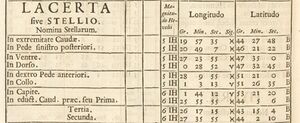Lacerta
An early modern constellation invented by Jan and Elizabeta Hevelius during their observations in the 1680s. It was introduced in their star catalogue of 1687 and depicted on the star atlas 1690, both published under the name of Johannes Hevelius, the latter posthumously by his wife. Lacerta is now one of the 88 official IAU constellations.
Etymology and History
Hevelius's description:
Secundò, Lacertam sive Stellionenm , quam inter Andromedam, & Cygnum reposui, eam ob causam elegi, quòd ibidem in tali angusto loco magnum aliquod animal consistere minimè posset, etiamsi decem lucidissimis Stellulis, Spatium istud esset resertum: adhrec, ut Autores volunt, sit animalculum versicolor , quasi plurimis Stellulis exornatum; id quod Nostro animalculo Coelestis omnium optimé convenit.
English:
"Secondly, I placed the Lizard or the Stellion between Andromeda and Cygnus; I chose it for this reason, that in such a narrow space a large animal could not possibly exist, even if that space were occupied by ten very bright stars: furthermore, as the authors say, it is a multicoloured little animal, as if adorned with many stars; this suits our little celestial animal best."
The area was left empty in Greco-Roman antiquity, as there are only a few bright stars. α Lacertae is with 3.75 mag the only one brighter than 4 mag. Ptolemy's star catalogue is only complete until 4.2 mag, and it became relevant to close this gap between Andromeda and Cygnus only since astronomers surveyed the stars systematically with telescopes — the other stars in Lacerta between 4 and 5 mag form a zigzag pattern.
Mythology
Weblinks
- Ridpath, Ian, Star Tales: Lacerta.
- Allen, R. H. Star Names: Lacerta






